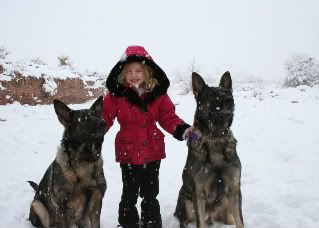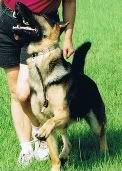lol, Anita the video assumes that the dog already knows the basic commands.
You do see a young pup (a 3-4 month German shorthaired pointer, I believe) working on the log on the very basics. She learns to stay on the log when her handler circles around her.
If you watch the older dogs (as in, over 6 months), they already know the commands and the handlers use a lot of leash "pops" to get the dogs to obey on the log. For example, the command "platz" followed by downward pops to get the dog to down (done with a flat collar on the log, not prong, it's not so much a correction as it is insisting that the dog "platz").
Obviously with young puppies you don't want to be popping them around so much. Ed's marker training method is better for that

Also, it's too much to expect the kind of attention and eye contact from a young pup that's shown on the video.
They don't have the attention span yet, so you'd be teaching the easier commands with markers for babies.
Very young pups should be taught the commands, but only using motivation and play. You can excite them and coax them into coming to you; giving them a pop on the leash to get them to you (like in the video) works great for the older pups, but isn't a good way to go with the babies. Once they're old enough to be introduced to the correction phase, the video would apply perfectly.
The heeling training uses food (and toys too) to motivate the dog, but you also give prong corrections when the dog breaks eye contact with you.
It's up to you, really

You can see for yourself if your pup is mature enough to move on to the attention exercises. It's also up to you to decide if your pup is old enough to go through a correction phase. It's demanding on the dog, so best to wait until the pup is more mentally mature.
If your pup is well bonded to you, is used to coming (happily) to you when called and pays attention to you during training, it's probably ready to go through Tom's initial attention exercises (no corrections there).
If the pup knows the basic commands pretty well, you could start working it on a log with lots of motivation and again, starting the eye contact exercises shown by Tom.
I can give you my example; it was my first time doing real training so I was worried about screwing my pup up

By 5 months he was doing great with the commands on a small table (I found one in a local playground that's perfect for the work).
I was lucky in that he was always extremely attentive and focused on me, so the exercises where you get the dog to follow you around and watch you were easy for us and we breezed through those.
In my case, I found that it took a couple of months for him to get used to catching food treats from my mouth. Until he was 7-8 months he couldn't catch the treats and would drop them and then take them off the ground (which is completely counter productive in getting eye contact! lol).
Unfortunately I couldn't use the method of having him take the treat from my mouth because he will grab my face (and rip it off

) if I tried to do that.
It wasn't until he was maybe 7 months old that I started the "leash pop" (with a flat collar) method to reenforce the commands - sit/down on a table, and the come to front.
In my case, my pup wasn't ready to start heeling until almost 9 months. I'm glad I waited for him to mature a bit before starting corrections though; his obedience work is always super happy and quick

I got to the point where I would put him into a "sit" in heel position and he would give me good eye contact. I would then drop pieces of food from my mouth and he would catch them.
He seemed a little confused when we first started the heel; he'd break eye contact as soon as we started walking (since he didn't know the command he'd assume that I'd released him).
We went back and worked a little more on the "watch me" command.
By the time he was 9 months old, he finally "got it" and the heeling work went smoothly from there :-)
Now when he breaks eye contact and I give him a quick prong pop, he understands the correction and gives eye contact.
It did take a while to get to this point though. Maybe experienced trainers can teach the eye contact thing more quickly (probably, haha) but if you're a novice like me, it's probably best to take it slow and not confuse your pup by asking too much of it too soon.
In my experience, expecting the pup to maintain eye contact is a much more difficult exercise than the simple "sit, down, come, stay etc.".
I hope this helps a little, I apologize for rambling on.
I guess in the end it's up to you to watch the dogs performing in the video and judge for yourself whether your pup is ready for that kind of work. Better to take your time in any case; the worst thing you could do is rush through the program before your pup is mature enough and use too much compulsion on him.
That'll suck his drive to work right out of him and it'll be impossible to get him to progress any further.
Good luck!!
Let us know how it goes with your pup if you go with the DVD!!
I'd definitely be interested in finding out how others progress through this. If you can find a way to progress more quickly than I did, please let me know!! I was extra cautious and took my time, but I'm sure that if done right you can teach the heeling sooner than 9 months.
(And Tom does show older dogs being worked with these methods. The only problem is that when dogs are started older they tend to have lost some of their drive. They're not as excited as the younger dogs over the food treats. As long as you worked your pup with a lot of motivation and food since it was a baby, you shouldn't have a problem with the loss of drive)

 Previous Topic
Previous Topic Index
Index Next Topic
Next Topic













 Top
Top





 ) if I tried to do that.
) if I tried to do that.

.jpg)
